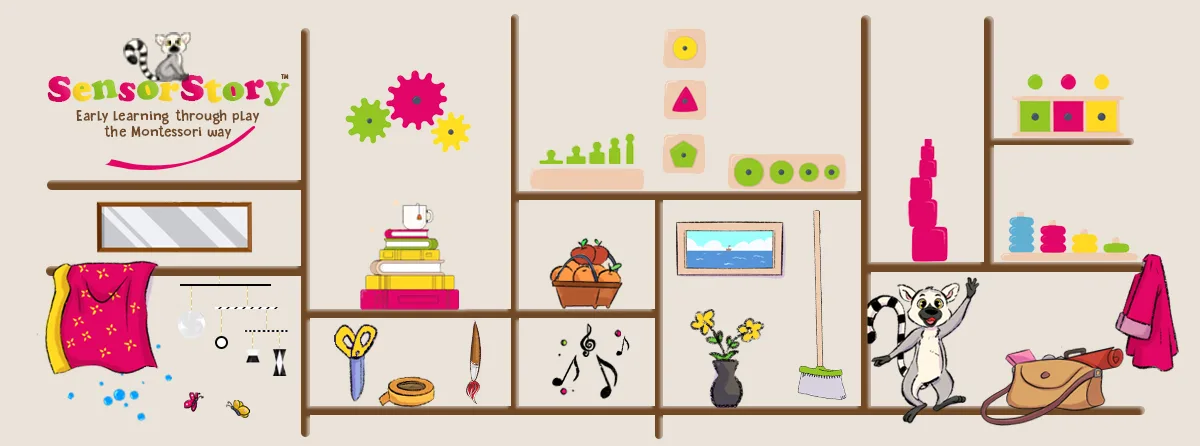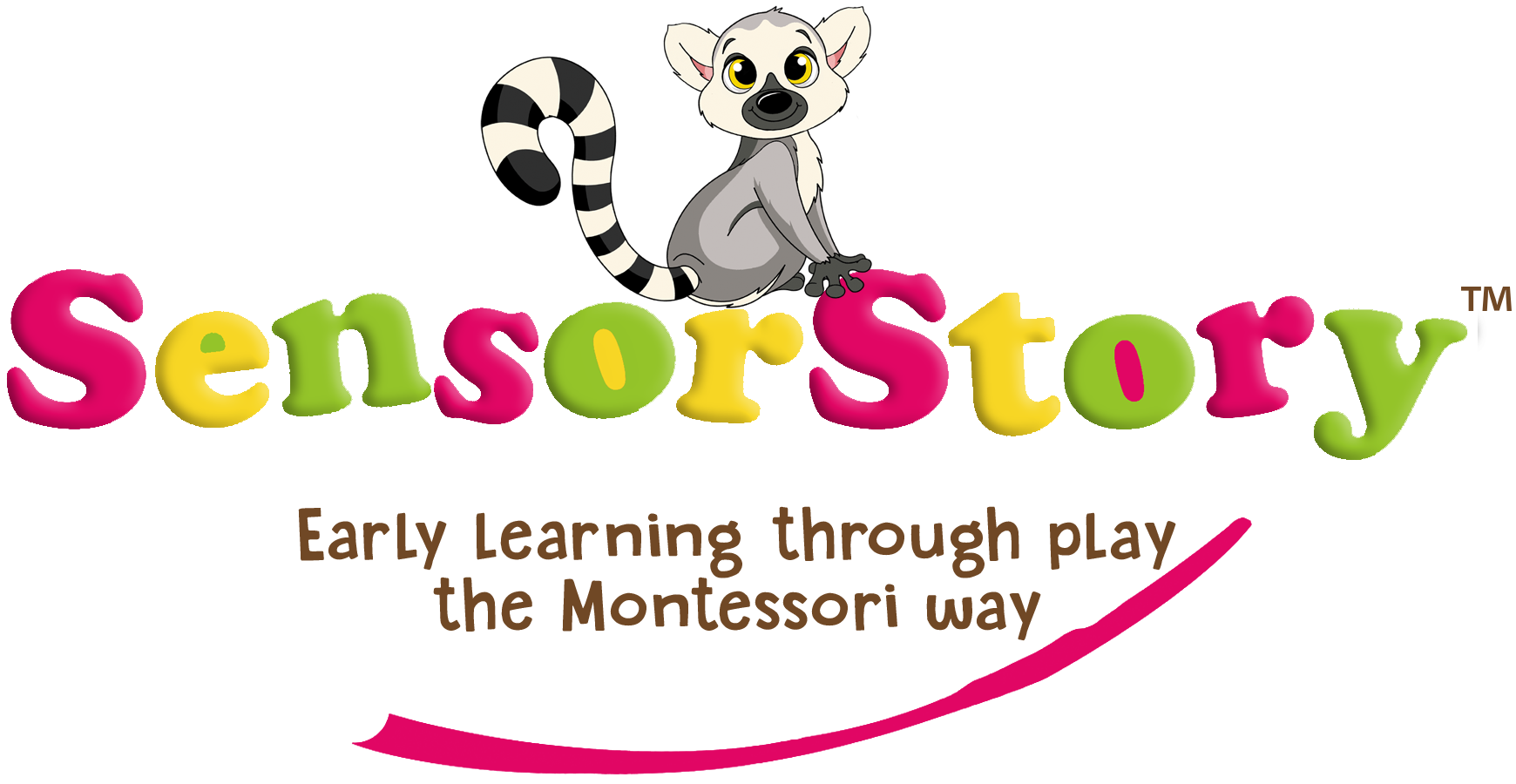We've put together a detailed list of at-home Montessori-aligned activities suitable for a 6-month-old.
Here you will see age-appropriate activities for all areas, in our Ultimate Series Of Activities to try at home, where the emphasis is on providing a prepared environment and allowing the child to actively engage in self-directed learning.
So what is my child working on mastering at this age?
Between the 6-9 month age, your baby's focus is on further developing sensorimotor skills. Your child is likely working on refining motor skills, such as sitting up and exploring the environment through crawling. Fine motor skills, like grasping objects, become more coordinated. Language development continues with exposure to speech and sound, and your baby is encouraged to engage in babbling. Independence is fostered through simple tasks, and a sense of order in the environment is introduced to provide security and predictability.

1. Sensory Exploration:
* Outdoor Sensory Play: Take short walks outdoors to experience natural elements.
* Provide a soft sensory mat with different textures for tactile exploration.
* Create baskets with soft, safe objects of various textures like fabric squares, soft brushes, or wooden rings.
* Gentle water play: provide a shallow container of water for supervised water play, introducing the concept of wetness and different temperatures.
* Offer fabric squares with mild scents (lavender, chamomile), introducing olfactory stimulation in a gentle way.
* Make or purchase soft, scented playdough for supervised play.
2. Visual Stimulation:
* Ball tracker; a series of ramps in a frame with a wooden ball a hole at top for posting the ball, encouraging visual tracking.
* Natural light and outdoor views: place your baby's play area near windows to allow exposure to natural light. Provide views of outdoor elements like trees and sky.
* Offer soft, squeezable mirrored balls for visual and tactile exploration.
* Floating objects in water: use a shallow container with floating objects, like rubber ducks or foam shapes, providing an opportunity for water play and visual focus.
* Place soft, natural-fiber toys in baby's environment: toys made from natural materials like cotton or wool, ensuring materials are safe for exploration and mouthing.
3. Auditory Stimulation:
* Introduce small musical instruments like a soft drum or xylophone.
* Use soft-sounding wind chimes placed in a gentle breeze to allow baby to hear different tones.
* Play recordings of nature sounds, such as gentle rain, birdsong, or ocean waves.
* Play soft lullabies or classical music during calm moments. Choose music with a slow tempo and soothing melodies.
4. Movement:
* Provide a soft padded mat for tummy time, encouraging your baby to strengthen neck and upper body muscles.
* Introduce soft balls that encourage reaching, grasping, and rolling on the floor.
* Crawling tunnels: create a soft, safe tunnel for your baby to explore, promoting crawling movements.
* Soft climbing mats or cushions: create a soft, padded area with cushions or mats for baby to practice rolling and crawling.
* Set up a low baby gym with hanging toys for the baby to reach and swat.
5. Grasping and Reaching:
* Offer soft, graspable toys with graspable rings for baby to hold and explore.
* Introduce a Montessori Grasp ball.
* Encourage reaching for hanging toys on a baby gym.
6. Exploration and Mouthing:
* Soft Cloth Teething Toys: Provide cloth teething toys for gentle chewing and tactile exploration.
* Wooden teething rings: provide wooden teething rings for your baby to explore through touch and mouthing.
* Provide a small basket of safe, non-toxic objects for your baby to explore with their hands and mouth.
* Offer a teething toy or soft fabric for mouthing and sensory exploration.
* Explore baby-safe household items, such as a soft brush or cloth.
7. Interaction with Faces:
* Use a small hand mirror for the baby to observe their own facial expressions.
* Engage in face-to-face interactions, making eye contact and expressing warmth.
* Encourage your baby to imitate simple facial expressions.
* Offer a soft, plush toy with a friendly face for baby to focus on.
* Use a soft-touch book with photos of diverse baby faces, showing happy, sad, sleepy faces. You can make the same expressions.
8. Language
* Multisensory storytelling: engage in soft, multisensory rhythmic storytelling during quiet moments.
* Engage in Baby Sign Language with your baby. To learn more about using Baby Sign Langauge click here.
* Read soft, cloth or board books with simple photos or beautiful illustations.
* Engage in conversations with your baby, narrating what you are doing or describing what they are seeing, to help them develop their listening and communication skills.
* Introduce soft animal toys introducing basic vocabulary through play.
* Sing gentle nursery rhymes and lullabies, introducing your baby to rhythmic patterns and melodic sounds.
9. Mirror Play:
* Introduce a baby-safe mirror for self-recognition and exploration.
* Encourage your baby to reach for their reflection and explore their own hands and face.
* Use the mirror during tummy time or once they begin sitting.
10. Culture:
* Introduce wooden animal figures for gentle play and exploration.
* Include soft toys or dolls dressed in traditional clothing from various cultures for baby to observe and touch.
* Soft outdoor blanket: use a soft blanket for outdoor play and relaxation.
* Offer textured art materials for tactile exploration.
* Outdoor nature walks: take baby for short walks in nature.
* Sensory exploration in the garden: allow baby to touch and feel soft grass, leaves, and flowers.
* Have beautiful art and photos in baby's environment at eye height for them to absorb.
* Introduce safe natural items like pinecones or fabric versions for visual and tactile stimulation.
11. The Whole Child Development:
* Attend our weekly SensorStory Baby and Toddler Montessori parent-child sensory classes! Follow this link to enrol your infant here.
We hope we have given you some inpiration for activities to do with your 6-month-old!
Remember, follow the child, adapting activities based on your observation of your baby's developmental stage and individual interests. The key in a Montessori environment is to provide your child with real, purposeful, and age-appropriate tools and materials that allow them to engage in activities independently and at their own pace.
Disclaimer: Adult supervision is required for any activity suggested by SensorStory. Please follow any directions and/or warnings on the labels(s) of any materials used during such activity & be aware of any potential choking hazards or allergies.
Click here to see our
Activities To Do With A 7 Month Old
FAQ.
